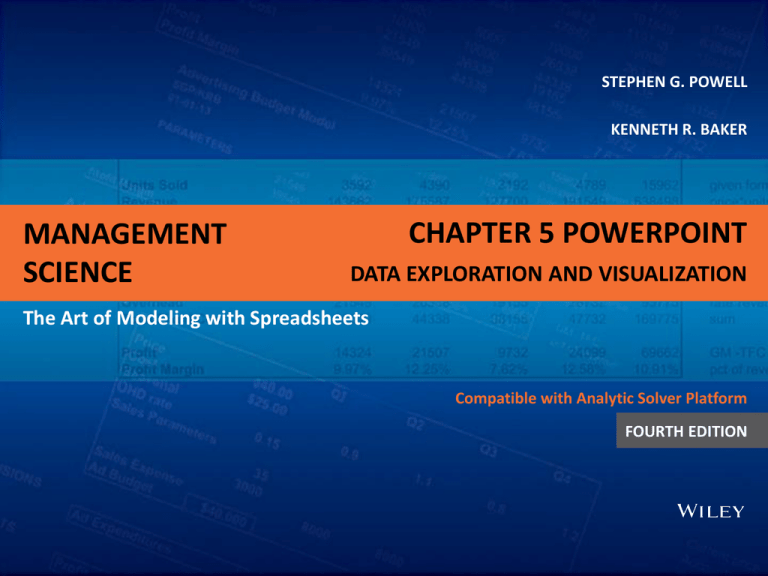
STEPHEN G. POWELL
KENNETH R. BAKER
MANAGEMENT
SCIENCE
CHAPTER 5 POWERPOINT
DATA EXPLORATION AND VISUALIZATION
The Art of Modeling with Spreadsheets
Compatible with Analytic Solver Platform
FOURTH EDITION
INTRODUCTION
• Business analysts must know how to use data to derive business
insights and improve decisions.
• Analysts may use data to describe situations (e.g., profit over the
last year), predict situations (e.g., profit over the next year), or
prescribe actions the organization must take to achieve its goals.
• Several basic skills are required to understand a data set, explore
individual variables (or groups of them) for insights, and to prepare
data for more complex analysis.
• Remain skeptical of data: datasets are only as good as their
collection methods (e.g., may have been collected with biases), and
may or may not be relevant to the problem at hand.
Chapter 5
Copyright © 2013 John Wiley & Sons, Inc.
2
DATABASE STRUCTURE
• Spreadsheet databases are two-dimensional files (versus
more complex relational databases).
• Consist of:
– Rows = records (sometimes, “cases” or “instances”)
– Columns = or fields (sometimes “variables,” “descriptors,”
“predictors”
• Most databases contain a data dictionary that
documents fields in detail.
Chapter 5
Copyright © 2013 John Wiley & Sons, Inc.
3
DATABASE STRUCTURE, EXAMPLE
• The data dictionary for
this sample:
Field Name
ID
ITEM
Description
Record number
Item number
UPC
DESCRIPTION
SIZE
STORE
WEEK
Uniform Product Code
Description
Items per container
Store number
Week number
SALES
Sales volume in cases
Chapter 5
Copyright © 2013 John Wiley & Sons, Inc.
4
DATABASE STRUCTURE, EXAMPLE
• We might use this
database to answer the
questions:
•
•
What were the market shares
of the various brands?
What were the weekly sales
volumes at the various
stores?
Chapter 5
Copyright © 2013 John Wiley & Sons, Inc.
5
TYPES OF DATA
• An infinite variety of data, but just a few common types:
– Categorical data, which includes nominal and ordinal data
– Numerical data, which includes interval and ratio data
Chapter 5
Copyright © 2013 John Wiley & Sons, Inc.
6
TYPES OF DATA: CATEGORICAL VARIABLES
• Nominal data, which simply names the category of
record.
– Example: A GENDER field, with only two variables (male
and female)
– Example: The DESCRIPTION field in previous slides, with
numerous variables (e.g., ADVIL, TYLENOL X/STRGTH LIQ).
• Ordinal data, also identifies category of record but with a
natural order to the values.
– Example: High, Medium and Low
– Example: Numerical rankings, where 5 = most preferred, 1
= least preferred
Chapter 5
Copyright © 2013 John Wiley & Sons, Inc.
7
TYPES OF DATA: NUMERICAL DATA
• Interval data, which conveys a sense of the difference
between values.
– Example: The Fahrenheit scale.
• Ratio data, based on a scale with a meaningful zero
point.
– Example: Monetary units, ages.
Chapter 5
Copyright © 2013 John Wiley & Sons, Inc.
8
DATA EXPLORATION
• Databases are highly structured for storage but do not
automatically reveal patterns and insights.
• We explore databases in a five-step process:
1.
2.
3.
4.
5.
Chapter 5
Understand the data
Organize and subset the database
Examine individual variables and their distributions
Calculate summary measures for individual variables
Examine relationships among variables
Copyright © 2013 John Wiley & Sons, Inc.
9
UNDERSTAND THE DATA
• Be skeptical of data, and ask:
– How are fields defined?
– What types of data are represented?
– What units are the data in?
• Example: Job applicants database
– SEX and AGE are unambiguous, but, does CITZ CODE (with U for US, N
for non-US) represent country of birth? Or citizenship? Where the
applicant currently lives? Know how the variable was coded.
Chapter 5
Copyright © 2013 John Wiley & Sons, Inc.
10
ORGANIZE AND SUBSET THE DATABASE
• Two essential tools: Sort and Filter
– On the Home ribbon in the Editing group and the Data
Ribbon in the Sort and Filter group
• Question: In the Executives database below, do any
duplicate records (EXECID) appear?
Chapter 5
Copyright © 2013 John Wiley & Sons, Inc.
11
ORGANIZE AND SUBSET THE DATABASE (CONT’D)
• Home►Editing►Sort & Filter►Custom Sort opens the
Sort window
– We sort by the EXECID column, sort on Values, and in
order of A to Z, and click OK.
– We can then scan for duplicate numbers (which appear
above one another)
Chapter 5
Copyright © 2013 John Wiley & Sons, Inc.
12
ORGANIZE AND SUBSET THE DATABASE (CONT’D)
• We can sort by more than one criterion using Add Level,
for example:
– ROUND then INDUSTRY then JOB MONTHS
– But, ties on the first criterion will be broken by the second,
and the second by the third.
Chapter 5
Copyright © 2013 John Wiley & Sons, Inc.
13
ORGANIZE AND SUBSET THE DATABASE: FILTERING
• Filtering allows us to probe a large database and extract
what interests us.
• Example: In Applicants database, what are the
characteristics of applicants from nonprofit
organizations?
• Home►Editing►Sort & Filter►Filter. Click on Industry
Description, and uncheck Select All, then check
Nonprofit.
• Does not delete other records, only hides them
Chapter 5
Copyright © 2013 John Wiley & Sons, Inc.
14
EXAMINE INDIVIDUAL VARIABLES AND THEIR DISTRIBUTION
• For numerical variables, we typically want to know the
range of records from lowest to highest, and areas where
most outcomes lie.
• Example: In Applicants database, what are typical values
for JOB MONTHS and what is the range from lowest to
highest?
• A common way to summarize a set of numerical values is
the histogram, although Excel provides eight choices.
Chapter 5
Copyright © 2013 John Wiley & Sons, Inc.
15
EXAMINE INDIVIDUAL VARIABLES AND THEIR DISTRIBUTION
(CONT’D)
• In XLMiner add-in, choose
Explore►Chart Wizard, and
the screen at top right
appears.
• In subsequent windows
choose Frequency for Y axis,
JOB MONTHS for X axis, and
the histogram at bottom
right appears.
Chapter 5
Copyright © 2013 John Wiley & Sons, Inc.
16
CALCULATE SUMMARY MEASURES FOR INDIVIDUAL
VARIABLES (CONT’D)
• Excel provides numerous functions useful for
investigating individual variables.
• Some can summarize the values of numerical variables;
others can be used to identify or count specific variables,
both numerical and categorical.
• Example: What is the average age in the Applicants
database?
Chapter 5
Copyright © 2013 John Wiley & Sons, Inc.
17
CALCULATE SUMMARY MEASURES FOR INDIVIDUAL
VARIABLES
• The most common summary measure of a numerical
value is average or mean.
• Calculate using the AVERAGE function in Excel, for
example:
AVERAGE (C2:C2918) = 28.97
• Other useful summary measures are median, minimum,
maximum.
Chapter 5
Copyright © 2013 John Wiley & Sons, Inc.
18
EXAMINE RELATIONSHIPS AMONG VARIABLES
• In many cases relationships among variables are more
important in analysis than the properties of one variable.
• Graphical methods can track relationships.
• Example: How long have older applicants held their
current jobs?
Chapter 5
Copyright © 2013 John Wiley & Sons, Inc.
19
EXAMINE RELATIONSHIPS AMONG VARIABLES (CONT’D)
• Use XLMiner to create a
scatterplot between AGE
and JOB MONTHS in the
Applicants database.
• Select Explore►Chart
Wizard►Scatterplot Matrix.
• Select variables AGE and
JOB MONTHS, then click
Finish for results at right.
Chapter 5
Copyright © 2013 John Wiley & Sons, Inc.
20
EXAMINE RELATIONSHIPS AMONG VARIABLES (CONT’D)
•
Relationships may be more complex,
based on numerous variables.
– Example: How does the distribution of
GMAT scores of applicants compare
across the five application rounds?
•
•
•
This asks us to compare five
distributions, each with considerable
information.
Boxplot option in XLMiner can
generate a chart summarizing
numerous statistics (e.g., mean,
median).
Select Explore►Chart
Wizard►Boxplot select variables
GMAT and ROUND, click Finish.
Chapter 5
Copyright © 2013 John Wiley & Sons, Inc.
21
SUMMARY
• The ability to use data intelligently is a vital skill for business
analysts.
• Analysts tend to perform most of their analysis in Excel.
• Understanding the data is the most important step, before
undertaking any analysis.
• Careful preparation of raw data is often required before data
mining can succeed.
– Missing values may have to be removed or replaced with average
values.
– Numerical variables may need to be converted to categorical values
(or vice versa).
– Normalization of data may be required.
Chapter 5
Copyright © 2013 John Wiley & Sons, Inc.
22
COPYRIGHT © 2013 JOHN WILEY & SONS, INC.
All rights reserved. Reproduction or translation of
this work beyond that permitted in section 117 of the 1976
United States Copyright Act without express permission of
the copyright owner is unlawful. Request for further
information should be addressed to the Permissions
Department, John Wiley & Sons, Inc. The purchaser may
make back-up copies for his/her own use only and not for
distribution or resale. The Publisher assumes no
responsibility for errors, omissions, or damages caused by
the use of these programs or from the use of the information
herein.









